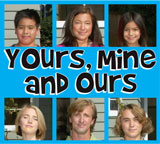 For Samantha,* family life has not turned out the way she imagined. Samantha is pregnant and has a toddler with her current husband. She also has a 16-year-old stepdaughter, Melissa*, from her husband's first marriage.
For Samantha,* family life has not turned out the way she imagined. Samantha is pregnant and has a toddler with her current husband. She also has a 16-year-old stepdaughter, Melissa*, from her husband's first marriage.
Samantha says that although she and Melissa get along well, "it's still really hard." Samantha didn't like losing control of her personal life. "When you're planning your wedding, you plan around your stepchild; when you have another child, you need to think about how it will affect your stepchild. When you plan your life, you don't want to think about this stuff. And I do. I'd do it again. Because I get my husband out of this too."
Samantha's stepdaughter lives with the Seattle couple most of the time -- she's with her mom every other weekend. So Samantha fills the parenting role, making Melissa's dinner and driving her to see friends. As a stepmother in a blended family, the lack of gratitude and stress inherent in parenting a teen are magnified, she notes. "It's a thankless job. It's like babysitting 24 hours a day. You need your spouse to appreciate you," she says.
Samantha cares for her stepdaughter but says the emotion is not the same as the unconditional love a parent has for a biological child. "You love your kids so much it hurts; it's OK when they throw themselves on the floor at QFC." But when the tantruming child is not your own, it's a different story. "(Step-parenting has) all the drawbacks of parenting without the feeling underneath," Samantha notes.
Therapist Barbara Perlmutter, MSW, who specializes in stepfamily consultation and counseling, says Samantha's feelings are common. Many stepparents feel that something's wrong or "feel crazy," wondering, "Why don't I love this child?" She says, "When people find out what they feel is natural, normal and get support and ideas for how to deal with the problems in the situation, things get so much easier."
Every day, across the U.S., more than 1,300 blended families are formed. According to the 1999 book Blending Families by Elaine Fantle Shimberg, there are an estimated 5.2 million U.S. stepfamilies.
What is a blended family? For many, it's the preferred term for a stepfamily, stripped of the stigma of evil stepmothers and broken homes. Some call the term contrived; others find it inspiring. Either way, a blended family is a combination of remarried or living-together partners, children and the extended family, the "ex-relatives," as Shimberg calls them, who continue in the child's life -- grandparents, aunts and uncles, cousins.
"Stepfamily is a more legal term; blended family is more the term for people living together who aren't all biologically related," says Colleen Holbrook, LICSW, CMHS, a child and family therapist who practices in Edmonds. Holbrook says the key point of difference from first-time families is: "If it's a blended family, it's starting with loss, a relationship that ended. Kids are not necessarily going to like having things all shifted and changed, so expect your child to be mad."
In the archetypical blended family, portrayed in the television show "The Brady Bunch," nothing seemed simpler than joining two family units into a happy, loving home. When Carol and Mike got together in 1969, there was rarely a defiantly slammed door, and viewers got the message that remarriage with kids in a blended family was smooth sailing.
But as millions can attest, and statistics bear out, the reality of a blended family is anything but. According to the 2004 book Remarried with Children by Barbara LeBey, 60 percent of remarriages will end in divorce: "But more than 51 percent of nuclear marriages also end in divorce, and more than 85 percent of these divorces will remarry. And second marriages with children are twice as likely to end in divorce as those without. More than half of Americans today have been, are now, or will be in one or more blended families during their lives."
Furthermore, LeBey writes, "As of the year 2000, blended-extended families became the norm -- that is, the dominant family structure -- with more than 50 percent of U.S. families falling within this definition." That amounts to a lot of kids being mad.
When mixing marriage and kids, "There's nothing Brady Bunch-ish about it," says Sheri Davis, MSW, a licensed clinical social worker practicing in Bellevue, who as a teenager was part of a blended family that separated. "For most people there's a lot of baggage from the previous relationship. I think it's different if (the situation) is divorce vs. death."
After a mother or father dies, Perlmutter adds, "they tend to become a saint. If a child is at a developmental age, to lose a parent is a devastating loss." From there, she says, kids and adults come to a second marriage with different expectations. Adults are thinking, "Won't it be ducky because now they have a new mother or father?" And the kids are thinking, "I don't want a new mother or father."
Whether the situation is death or divorce, Davis says, the adjustment to a second, blended family "will depend on the coping skills that the children and parent has utilized to deal with a loss."
Is it really possible to genuinely blend a family? Perlmutter objects to the term "blended family." "People don't blend," she says, emphasizing that the expression causes unrealistic expectations. With the exception of people who grew up in stepfamilies, she says that often couples feel the adjustment will be fast, easy and result in a life akin to a nuclear family -- a setup for big disappointment. A healthier approach, she says, would be: "It's going to take time, because relationships take time. When kids are involved, the kids have already learned that family doesn't last, so it's very challenging. A lot of times kids are afraid to trust again, and they feel threatened by their biological parent's attention for somebody else."
When they started dating in 1992, Treuman and Sue Ellen Katz of Bellevue sought premarital counseling. Sue Ellen says, "We wanted to be able to do the right thing. We needed a safe place to work out issues that might come up." Treuman had three children (now ages 30, 35 and 37); Sue Ellen had two (now 28 and 30). They married a year after they met, and during their first year of marriage, Treuman's daughter, his youngest child, lived with the couple and Sue Ellen's son stayed with them frequently.
Treuman had been married for 27 years, and his sons were living out of town during the decline of his marriage to his first wife. Although his daughter was supportive of his relationship with Sue Ellen, the boys had a harder time adjusting. Sue Ellen says, "By the time we got married, we had gone around the block with the boys. They were pretty upset with him. They didn't know me, they were protective of their mom and I understood that." (Sue Ellen had been divorced for about six years.)
Looking back, Treuman wishes he had gone for counseling with his kids to help them heal from their parents' divorce. He says, "It was one thing for me to leave their mother, and another to get married." In addition, the path from dating to marriage had happened pretty quickly. Treuman also realizes he was misguided in his early thinking. As Treuman says, he had found a phenomenal person and assumed his children would quickly embrace her. He thought: "I love her; you should accept her."
Over time, Treuman says, his sons came to see him as a person evolving -- no longer "embattled," as he says, but in a good relationship -- and they were pleased. But Treuman also tuned in to their point of view: "I had to always be aware of their feelings and I needed to be careful talking about how happy I was, and never be pejorative about their mother."
In time, Treuman's sons supported their dad's second marriage, and all five kids have grown close, with incredible chemistry. Treuman says, "The way it worked out was remarkable despite my insensitivity."
As stepparents, the couple has had some happy surprises: Occasionally in cards or on the phone, the kids refer to them as "Dad and Mom." Describing their blended family's party of seven, Sue Ellen says, "It is the Brady Bunch, but we've worked at it; we all had our share of being at the therapist, anger and disappointment at one time or another. But we had great tools and resources."
To build a strong foundation for a blended household, Holbrook says that adults need to set expectations for how rules are made and enforced, with clear and consistent consequences. For instance, if a couple differ in their approaches to discipline or making sure homework gets done, the adults need to agree on enforcement. If not, Holbrook warns, "Kids will get in the middle of the parents."
Take a situation when the stepdaughter does something that antagonizes the stepmom, which the biological parent doesn't think is an issue. When reprimanded, the girl complains to her dad, feeling mad and victimized. If the couple do not present decisions as a team, Holbrook says, Dad might bond with his daughter against the stepmother. Such situations can form a wedge between the couple, weakening their union. Furthermore, some stepparents say they feel left out amid the intimacy between biological parent and child, and this dynamic can fuel these feelings.
Josephine* has stepchildren aged 17 and 18, plus 2- and 4-year-old biological children -- and her husband also has stepchildren from a previous marriage. She says that she and her husband have different approaches to childrearing, particularly when it comes to his teenage children in their blended family. "I don't think I'm overly strict. He doesn't think he's overly lenient and yet we don't agree. He thought his kids had been through so much -- a difficult divorce -- that he wanted to offer his children some calm in their lives. When my expectations of them exceeded his, we'd argue about it."
For example, Josephine expected the teens to do chores; they resisted, and her husband didn't feel they needed to do them either, so the situation was a stalemate. Josephine says such scenarios "can get into triangulating; the (kids) try to pit the adults against each other."
When these conflicts occur, she says, the biological parent has to communicate to the kids that although some things in their lives will stay the same, the original family also will have to change. "You've got to both do things to show this is the new relationship. The stepparent has made a huge change (in her life); the biological parent needs to support that. So you are both contributing."
Josephine's stepchildren lived full time with the couple for a year after she moved in. "If I could do it over again, I would start by trying to establish a good relationship with [my stepchildren] in our own terms, doing things with them away from my husband, where they would come to know I was a trustworthy person they could rely on," she says. "If that's not there, the step relationship can always be tenuous." When it comes to discipline, Josephine adds, "At any time, your step kids can say, 'You know, you're not my mom.'"
Amid the conflicts, soccer games and focus on everyone's needs, it's critical that the parents sustain their connection. For the marriage to last, Perlmutter says, "An enormous amount of attention has to be paid to maintaining a really strong couple, and whatever that takes, that is number one."
For the last four years, Josephine's family has participated in a gingerbread-making workshop. This past holiday season, the outing was scheduled with no resistance, and even the teenagers got into it. Her peace-minded stepdaughter personalized her creation with anti-war statements; her stepson illuminated his super-sized house with Christmas lights. This year, Josephine says, "I remember watching everyone make gingerbread houses, thinking, 'This is ours.'"
For Amy Low of Lake Forest Park, an important turning point in unifying her blended family was having a baby. Together the couple had a son, now 3, and they also have an infant. Low says the first baby gave her stepdaughter (who was 9 at their wedding, and is 13 now) a sense of connection to the family while securing Low's role. She says, "I was no longer Deirdre's stepmom; I was the mom of her brother, which is a different relationship."
Low suggests that parents be patient. "Time has a way of really creating these bonds," she says. "Frankly, in the beginning, (step parenting) was not all that natural. You just need time, history, family experiences, inside jokes, memories. You look up one day (and realize), we have a thing going on."
Adds Laureen Miki, coordinator for the Seattle/Eastside chapter of the Stepfamily Association of America, "If you make your priority to work with each other and be willing to compromise, then you can take on anything."
Michelle Feder writes about a variety of subjects. She has 4-year-old and 10-month-old sons.
Note: Names with a * have been changed to protect the privacy of families interviewed.
Resources for stepfamilies
- The Seattle/Eastside chapter of the Stepfamily Association of America meets every four to six weeks, and plans seminars and workshops. Contact coordinator Laureen Miki at 425-985-3890.
- Colleen Holbrook, LICSW, CMHS, Child and Family Therapist, 206-550-3502 or email colleenholbrook2003@yahoo.com. Holbrook offers a free 30-minute consultation.
- Sheri Davis, MSW, licensed clinical social worker, practices in Bellevue. 425-746-7338.
- G.I.F.T (Getting Interracial Families Together), is a new multiracial parenting group forming at the University Family YMCA. Participants meet twice a month (second and fourth Monday at 9 a.m.) to share resources and stories and to discuss reading materials. Open to all; child care is available for $2. For more information, contact Lonnie Rabel, University Family YMCA, 206-524-1400 or email lrabel@univ.seattleymca.org.
- Bellevue Youth Eastside Services holds a six-week class addressing the Effective Parenting of Teens (for parents of teens, ages 13 and up). For more information, contact the YES Intake office at 425-586-2312.
Books recommended by stepparents:
- Stepfamilies: Love, Marriage, and Parenting in the First Decade by Dr. James H. Bray and John Kelly
- Don't Be So Defensive! Taking the War Out of Our Words with Powerful Non-Defensive Communication by Sharon Ellison
- Stepcoupling: Creating and Sustaining a Strong Marriage in Today's Blended Family by Susan Wisdom, LPC, and Jennifer Green
- Get Out of My Life, But First Could You Drive Me & Cheryl to the Mall: A Parent's Guide to the New Teenager, Revised and Updated (Paperback) by Anthony E. Wolf
- Blending Families: A Guide for Parents, Stepparents, Grandparents and Everyone Building a Successful New Family by Elaine Fantle Shimberg
- Remarried with Children: Ten Secrets for Successfully Blending and Extending Your Family by Barbara LeBey
Originally published in the April, 2006 print edition of ParentMap.









